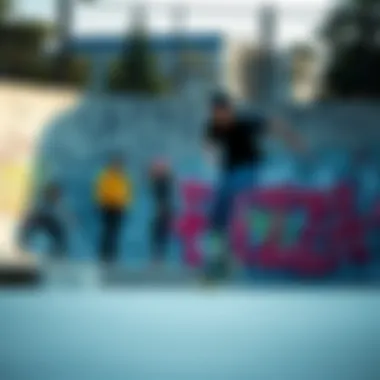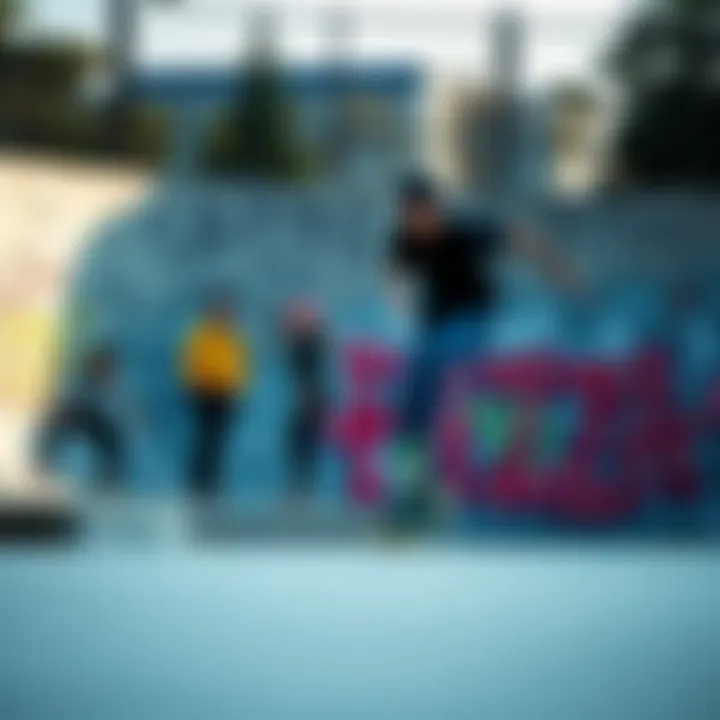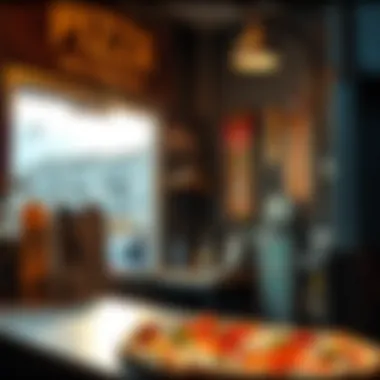The Intersection of Pizza and Skateboards: A Cultural Perspective


Intro
The melding of pizza and skateboarding offers a captivating glimpse into youth culture's vibrant and evolving nature. As simple as it might seem, the relationship between these two iconic elements goes deep, rooting itself in shared experiences, community gathering, and the entrepreneurial spirit that thrives in skate parks and surrounding locales. This exploration will navigate through their cultural significance, establishing how they intertwine in shaping lifestyles for thrill-seekers and adventure lovers.
Pizza serves as more than just a meal; it embodies a social glue, creating a sense of togetherness in a fast-paced world. From the classic pepperoni slice to gourmet artisan creations, food is often the centerpiece in skate parks where stories are shared and friendships are forged. Meanwhile, skateboarding, often viewed as an extreme sport, carries an air of rebellion and creativity, giving youths an outlet for expression and athletic development. Together, they create a unique cultural tapestry that resonates with the younger generations.
This article aims to unpack the comprehensive relationship between pizza and skateboarding, focusing on various facets including their origins, current trends, and how they encourage active community engagement. Let's embark on this journey into a world where flavors meet thrills, uncovering how pizza is more than a topping on a board—it’s a lifestyle.
Prelude to Pizza and Skateboarding
In today’s world, one thing that's undeniable is the symbiotic relationship between pizza and skateboarding. Many view them as just two separate interests, however, they together form a vibrant culture that binds communities, especially among the youth. When you grab a slice of pizza after a session at the skate park, you're not just filling your belly, you're participating in a shared ritual. This intersection is rich with narratives that reflect the spirit of freedom and creativity unique to both skateboarders and pizza lovers.
Beyond the deliciousness of these culinary and physical pursuits, they represent more than just pastimes. They articulate a sense of belonging, adventure, and rebellion. Skateboarding has long been synonymous with individual expression, while pizza serves as a common ground that enhances social interactions. It’s more than just a meal; it’s about camaraderie, fueling bodies before hitting the board, and celebrating victories with friends.
From the sketchy half pipes to the lively pizza joints nearby, this fusion tells a deeper story that includes challenges of entrepreneurship, community dynamics, and lifestyle choices that reflect a daring attitude.
As we explore this fascinating realm, we’ll uncover how these two cultures not only coalesce but also inspire one another, creating a unique space for innovation, shared experience, and a nudge toward creativity.
A Brief History of Pizza
Pizza, a word that evokes a thousand cravings, has a history that stretches back centuries. Its roots trace back to ancient civilizations that baked flatbreads, but it was Naples, Italy, in the late 18th century where the modern pizza truly found its home. The Margherita pizza, a vibrant trio of colors representing the Italian flag, was created in honor of Queen Margherita of Savoy.
Fast forward to the early 20th century, when Italian immigrants brought this delectable pie to the United States. Initially, it was enjoyed by the Italian community, but it didn’t take long for it to become an American staple. As it grew in popularity, various regional styles emerged, from the deep-dish of Chicago to the thin crust of New York. Today, pizza is not just food; it's a cultural phenomenon with countless interpretations around the globe.
The Evolution of Skateboarding
Skateboarding, on the other hand, has its own thrilling history, born out of the surf culture of the 1950s in California. What began as a way for surfers to practice on land during flat days quickly morphed into a subculture driven by creativity and experimentation. The boards evolved, techniques flourished, and a community of riders emerged.
The 1970s saw the birth of the first skate parks and the emergence of skateboard brands like Powell Peralta and Santa Cruz. Accomplished athletes, like Tony Hawk, took skateboarding to new heights, quite literally, introducing high-flying tricks that captivated audiences around the world.
As skateboarding thrived through the decades, it adapted to the changing cultural landscape, incorporating elements from punk rock in the ‘80s, embracing street skating in the ‘90s, and now blossoming into an Olympic sport. Each era has contributed to shaping the diverse identities within skateboarding, demonstrating its lasting relevance and impact.
Understanding these histories deepens our appreciation of how pizza and skateboarding intertwine today, creating a lively ecosystem that embraces both the physical rush of the board and the communal pleasure of good food.
Cultural Significance of Pizza
The significance of pizza stretches far beyond mere sustenance; it serves as a connective tissue for communities, particularly among youth and active lifestyles. Pizza, in its many forms, embodies comfort, celebration, and shared experiences. Within the context of skateboarding culture, this food item becomes more than just a meal; it transforms into a staple that accompanies countless hours spent at skate parks and events. Let's delve deeper into the roles pizza plays in the skater community, the stories behind different varieties, and how these elements intertwine.
Pizza as a Symbol of Community
When skaters gather at parks, you can almost guarantee a pizza box is present. In many ways, pizza represents community spirit. Groups of friends often congregate around a large pie, sharing slices as they recount the day’s battles against gravity and flip tricks. This act of sharing food fosters bonds that go beyond the individualistic approach often associated with extreme sports. The aroma of pepperoni and melting mozzarella can often be the backdrop to laughter, encouragement, and camaraderie.
Moreover, many skate shops recognize this bond. They often team up with local pizzerias, turning shops into hubs not just for gear, but for communal gatherings. It’s common to spot flyers for upcoming skate competitions or local events pinned alongside menus from nearby pizza joints. This collaboration not only enhances community interactions but also helps local businesses thrive.
To illustrate, consider the case of a well-known skate park in Portland. It regularly hosts events called "Slice and Skate,” inviting local skateboarders to showcase their skills while enjoying pizza from a nearby pizzeria. These types of events illustrate how pizza can strengthen community ties, promoting healthy competition while highlighting local culinary delights.
Regional Varieties and Their Stories


Pizza, as a cultural product, varies widely across regions, and each variant embodies unique local flavors and stories. For example, New York-style pizza is famed for its thin, crispy crust and generous folding technique, suitable for a fast-paced city life. In contrast, Chicago deep-dish offers a heartier experience, with layers of cheese and toppings nestled amid a thick crust that takes time to savor. Each style has its enthusiasts who passionately debate which is superior, elevating the pizza experience into a cultural phenomenon.
Across the world, variations continue to pop up. In Japan, for instance, you might find teriyaki chicken or squid toppings, reflecting local preferences. This adaptability helps pizza to transcend its Italian origins, weaving itself into the fabric of diverse communities. Each slice tells a story, be it the classic Sicilian methods or the new-age gourmet combinations emerging in urban gourmet spaces.
"Pizza's history is a reflection of society's evolving tastes. It's not just a dish; it's a representation of culture and community."
As skateboarding itself evolves, so does its relationship with food. Skate culture integrates these regional flavors into its identity by collaborating through local pizzerias that offer specialty pies tailored for skaters. These partnerships foster an atmosphere of belonging and identify with distinct local flavors, enriching both communities.
Skateboarding and Youth Identity
Skateboarding is more than just a sport; it’s a vital thread interwoven into the tapestry of youth culture. For many, it serves as a gateway to self-discovery, offering a canvas for personal expression and forging robust community bonds. The simple act of riding a skateboard can signal a young person’s values, identity, and place within a larger social landscape. Factors such as freedom, rebellion, and creativity are often at the heart of it. In this section, we will delve deeper into how skateboarding nurtures identity, promotes individualism, and shapes social dynamics among the youth.
Skateboarding as a Form of Self-Expression
Every push and glide on a skateboard carries with it the potential for self-expression. This dynamic sport allows skaters to showcase their personality, whether it be through their tricks, their choice of boards, or their fashion. The various styles of skateboarding—from street skating to park and vert—are reflections of one's personal identity.
- Tricks as a Voice: Each skateboard trick can be seen as an extension of one's identity. For example, doing a kickflip speaks to a certain level of skill and confidence, while a simple ollie might represent a more laid-back approach.
- Custom Boards: Many skaters invest in customizing their boards with artwork, stickers, and colors that resonate with their unique style. This personalization transforms a skateboard into not just a tool for sport—but also a personal statement.
Moreover, skateboarding gives youth a sense of belonging. Skating with friends at a local park creates shared experiences, where the camaraderie is intertwined with individual expressions. Whether they land a new trick or simply enjoy rolling together, these shared moments are foundational to how identity is formed in this subculture.
Influence of Skate Culture on Fashion and Attitudes
The relationship between skateboarding and fashion is a two-way street, with each influencing the other significantly. The skateboarding community has cultivated a distinctive style that has crossed over into mainstream fashion.
- Street Style Evolution: In the 1980s, baggy jeans and oversized tees became synonymous with skate culture, paving the way for modern streetwear trends. Today, these looks have infiltrated high-fashion runways and popular retail.
- Iconic Brands: Companies like Vans and Thrasher have become staples in both skateboarding and everyday wear. Their logos often signify membership in a subculture that embraces a sense of freedom and non-conformity.
"Skate culture isn't just about riding a board; it's about embracing a lifestyle that challenges the norm and expresses individuality.”
The skaters' attitudes also embody a unique philosophy. There's an inherent resilience that comes from the persistence to face falls, failures, and challenges. This perspective cultivates a mindset that values hard work and self-improvement, extending beyond the realm of skating into life at large. In many ways, skateboarding becomes a metaphor for navigating the ups and downs of growing up. The lessons learned on the board often parallel the challenges faced in day-to-day life, fostering strength, creativity, and a healthy sense of rebellion against complacency.
Through skateboarding, youth find an avenue to channel their diversity, creativity, and collective experiences into a formation of identity that is as vibrant as it is authentic.
The Blending of Pizza and Skateboarding
The intersection of pizza and skateboarding represents a compelling narrative in youth culture and community interaction. These two elements intertwine not merely through shared spaces and activities but also through a shared ethos of creativity and rebellion. Skateboarding, with its roots in counterculture, naturally resonates with the laid-back, community-oriented aspect of pizza. Together, they create a unique blend where food becomes a part of the skateboarding experience, enhancing gatherings and fueling the energy of skateboarders.
Skate Parks: The Unofficial Pizza Hubs
Skate parks have evolved into much more than just a place to practice tricks; they are informal gathering spots where friendships are forged and passions are shared. The relationship between skateboarding and pizza is vivid here. After completing a challenging run or nailing a new trick, it's common for skateboarders to congregate around a pizza box, sharing slices and stories. It's not just about the food—it's the culture that surrounds it.
These parks often sit in neighborhoods where local pizza joints thrive, creating natural synergies. A skateboarder might know their favorite pie joint better than they know the local school, turning the park into an unofficial hub for pizza lovers and skaters alike. Discussions ranging from the latest skateboarding moves to the perfect cheese-to-crust ratio happen here, blending skill and taste.
Moreover, local pizzerias often capitalize on this dynamic. They might sponsor skate events or provide discounts to skaters, integrating themselves into the lifestyle. It's a win-win; the shops get a steady stream of customers, while skateboarders enjoy affordable eats in a comfortable atmosphere. As the sun sets and day turns to night, you’ll often find those skate parks buzzing with the sound of skate wheels and laughter, while pizza boxes lay scattered around – testament to a day well spent.
Events That Celebrate Both Worlds
Events that draw connections between skateboarding and pizza offer a platform for showcasing talent, creativity, and community spirit. For instance, skateboard tournaments often feature food stalls where local pizza vendors set up shop, serving slices right on the outskirts of the skating action. These events are not just about competition; they're about uniting different communities over a shared love for skating and food.


Such events are usually a medley of tricks and tasty treats, where skateboarders demonstrate their prowess while fans cheer them on, sipping soda and munching on pizza. Think of contests that reward not just athletic skill but also creativity in skateboarding-style, often sponsored by pizza brands wanting to create a buzz. It's about creating a vibe where the love for skateboarding and pizza generates a lively atmosphere.
By combining these elements, you find both an opportunity to showcase the vibrant culture around skating and the families and friends who gather for these events, creating an environment rich with stories and shared experiences. Whether it's a charity event for a local park renovation or an informal competition among friends, every slice of pizza consumed is a contribution to the skate culture's growth.
"The blending of skateboarding and pizza is more than food; it's about creating moments that resonate with community and passion."
In summary, skate parks and related events serve as essential stacking blocks in creating an authentic synergy between pizza and skateboarding. These interactions solidify a culture where passion for extreme sports meets communal dining, revealing the layers of engagement that these two worlds can create when they come together.
Entrepreneurial Ventures at the Intersection
Entrepreneurial activities at the crossroads of pizza and skateboarding reveal a dynamic synergy that benefits both businesses and communities. This relationship is not merely coincidental; rather, it stems from the shared culture that enthusiasts from both realms embrace. By examining these ventures, we can appreciate how they foster community engagement, bolster local economies, and promote healthy lifestyles among youth.
Pizza Shops Targeting Skate Communities
Localized pizza shops have become crucial players in skate culture, often serving as safe havens for skateboarders while simultaneously providing delightful food options. For these establishments, understanding the unique preferences and habits of skateboarders is essential.
- Tailored Menus: Many pizza shops offering specialized menus featuring quick bites that cater to an active crowd. For instance, shops might offer "skater specials" during peak skating hours to attract skaters looking for refueling options.
- Skateboard-Friendly Environments: Shops with a laid-back atmosphere, where skateboarders can hang out post-session, tend to do better. Think of places adorned with skate art and hosting local exhibitions; these not only make for a cozy atmosphere but also attract foot traffic.
- Community Events: Hosting skate-related events or competitions brings both skaters and non-skaters together, turning the shop into a community hub. This approach not only builds a loyal customer base but also strengthens ties within the neighborhood.
Pizza shops are taking their roll as cultural ambassadors seriously, making them indispensable in the hybrid culture of skateboarding. They go beyond mere transactions; they become vital community spots where identity is forged and strengthened.
Skateboard Brands Collaborating with Pizzerias
A wave of collaboration has emerged between skateboard brands and pizzerias, signifying a powerful union that capitalizes on their shared audience. These partnerships work in numerous creative and beneficial ways.
- Cross-Promotional Products: Many skateboard companies now offer limited edition skate decks featuring pizza-themed graphics or even collaborations on clothing lines. By blending visuals of skateboarding and pizza, these brands appeal to both demographics seamlessly.
- Localized Branding: Partnering with beloved local pizzerias enables skateboard brands to resonate with regional identity. This connection enhances brand loyalty and creates a grassroots feel, making products more relatable.
- Events and Sponsorships: Hosting skate contests at local pizza shops or sponsoring pizza-themed skateboarding events can dramatically boost visibility. It encourages loyalty among skater communities while allowing businesses to tap into a larger market.
These partnerships serve to bridge gaps between the worlds of skateboarding and food, helping to cultivate a vibrant community that thrives on shared passions. By intertwining the culinary and athletic experiences, both sectors find new pathways toward longevity and relevance within their communities.
In summary, the entrepreneurial ventures blooming at the intersection of pizza and skateboarding illustrate a unique cultural fusion. These businesses not only create thriving economic ecosystems but also define the social fabric that binds community members together. The future lies in leveraging these avenues to inspire more innovative collaborations that resonate deeply with the youth.
Health Considerations: Nutrition and Activity
Skateboarding is more than just an exhilarating sport; it is often viewed as a lifestyle. To keep up with the physical demands of practicing tricks, riding ramps, or simply cruising around, a skateboarder needs to pay special attention to their diet. This section dives into the crucial balance of nutrition and activity, emphasizing how these elements enhance performance and overall well-being.
Balancing Diet with Active Lifestyles
Maintaining a well-rounded diet is essential for anyone involved in skateboarding. Engaging in such a physically intensive activity requires a focus on nutrient-dense foods that provide energy without weighing one down. Here are some key aspects to consider:
- Carbohydrates: They're the main source of fuel for high-energy activities. Foods like whole grains, fruits, and vegetables should play a significant role in a skater's daily intake. Think of brown rice or quinoa as reliable allies when tackling a long skate session.
- Proteins: They help to recover and build muscle. Skaters should include lean meats, legumes, and dairy in their meals to support their active lifestyle. A good rule of thumb is aiming for a source of protein with each meal.
- Fruits and Vegetables: Packed with vitamins and minerals, these are vital for overall health. A skater should not shy away from colorful veggies like bell peppers and sweet potatoes, which can help boost recovery post-session.
- Hydration: Often overlooked, staying hydrated is critical. Skateparks can be hot during summer months, making it easy to overlook the need for water. Carrying a water bottle can make this easier.
"Balancing a diet rich in nutrients keeps skaters nimble on their boards and helps fend off fatigue."
Balancing these elements can help skateboarders maintain energy levels during their rides, while also speeding up recovery times and minimizing the risk of injury.
The Role of Nutrition in Skateboarding Performance
Nutrition doesn’t just impact general health; it significantly influences performance on the board. Here's how the right nutrients can help:


- Enhanced Stamina: Skating involves bursts of activity that require immediate energy. Consuming complex carbohydrates prior to riding can provide sustained energy, allowing skaters to last through longer sessions.
- Improved Recovery: After a long day of skating, the body needs to recover. A balanced meal that includes proteins and carbohydrates can help replenish lost glycogen and repair muscles. This is crucial for those who hit the parks daily.
- Focus and Coordination: Nutrient-rich foods, especially omega-3 fatty acids found in fish or flaxseed, are known to promote brain health. Being sharp mentally helps skaters execute complex tricks smoothly and safely.
Perspectives from the Community
The blend of pizza and skateboarding embodies much more than mere food and recreation. It serves as a cornerstone of community life, drawing together diverse individuals who share these passions. Understanding the perspectives from both skateboarders and pizza shop owners helps unravel the impact these elements have on social dynamics. They often serve as informal gathering spots where friendships form and culture thrives, making this investigation vitally relevant.
Interviews with Skateboarders
Engaging with skateboarders brings some fascinating insights into how vital pizza is to their daily lives. When talking about their experiences in skate parks, many recall moments where a slice of pizza was not just sustenance but also a shared experience among friends. This camaraderie often shapes their lifestyle.
One skateboarder, Jake, highlighted the connection: "After a long day of skating, there's nothing better than heading to a nearby pizzeria with friends. It’s like a ritual; we skate, then we eat pizza. It's where we debrief on our tricks and laugh about our fails."
These interviews reveal that for many, the combination of skipping on a board while dreaming of cheesy toppings represents a fundamental aspect of youth culture. Also, it comes down to the fact that local pizza joints often foster a certain vibe, welcoming the gritty yet passionate spirit of skateboarders.
Moreover, they often create special deals that resonate with energetic skaters, making pizza readily available for after-skate sessions. This intertwining promotes community cohesion, blurring lines between business and leisure.
Voices from Local Pizza Shop Owners
Turning to local pizza shop owners gives a fresh perspective on how this unique relationship works. Many shop owners can recount tales where their businesses became a sanctuary for skateboarders seeking refreshments after a day of skating. They value this connection, recognizing that supporting the skate community brings them loyal customers.
Anna, owner of "Pizzatopia," shared: "I've seen the same kids come in for years. They start with skateboards under their arms and now they bring their friends’ kids. It's heartwarming to see that generational connection."
These establishments often adapt their menus, creating signature skate-themed pizzas that attract young locals. Especially in areas where skate culture thrives, this becomes a strategy to not only draw in skateboarders but also engage their families.
The relationship between pizza shops and skateboarders is more than transactional; it’s about creating safe spaces where youth can express themselves and connect over shared hobbies.
Additionally, these local businesses might sponsor skateboarding events, strengthening their ties with the community. Through these sponsorships, they offer discounts or promotional items, further embedding their brands into the local skating culture. In essence, the narrative shows a powerful synergy, a dance of commerce and creativity between skateboarders and pizza aficionados.
In this way, both perspectives—those of skateboarders and pizza shop owners—illuminate a culture that thrives in synergy, creating a vibrant community at the heart of urban life.
Culmination: A Unique Cultural Fusion
As the world spins at an increasingly fast pace, the intersection of pizza and skateboarding represents more than just a casual pairing; it embodies a vibrant cultural fusion that impacts community dynamics. This article has journeyed through the rich histories and the vibrant cultures surrounding pizza and skateboarding, revealing how these two seemingly disparate elements can create a powerful shared space. When skateboarders gather around a slice of pizza, they engage in a longstanding tradition of camaraderie, where relationships thrive and creativity ignites.
Reflections on the Impact of Combining Passions
Exploring this unique relationship, it becomes clear that the act of combining passions can lead to a myriad of benefits. Communities benefit from shared spaces that promote inclusion, where both seasoned skateboarders and novices can find common ground over an easy meal. The lessons learned in skate parks go beyond tricks and style; they offer insights on resilience, teamwork, and creativity. When individuals from varied backgrounds come together to share a meal, it breaks down barriers and cultivates understanding.
Pizza shops that cater specifically to the skateboarding culture often serve as unofficial gathering points. These locations transform into more than just eateries; they're hubs of creativity and social activity. People sharing their successes and struggles while munching on a slice creates an uplifting atmosphere. As one skater noted in an interview, "You can talk about that gnarly trick you landed while enjoying a slice; that’s just the way of our tribe."
Moreover, as skateboarding continues to gain recognition as a legitimate sport, the amalgamation of pizza culture serves to elevate a sense of belonging within the community. It reinforces the idea that you can juggle your passion for extreme sports with enjoyment for comfort food.
Future Implications for Community Dynamics
Looking forward, the fusion of pizza and skateboarding promises to reshape community dynamics in exciting ways. As skateboarding is embraced by mainstream culture, we could see the rise of more dedicated pizza places that draw inspiration from skate culture, perhaps even serving pizzas modeled after iconic skateboard designs. The synergies created between these two facets could lead to a thriving business vibe, with joint events that feature pizza tastings alongside skate competitions.
In addition, with evolving urban landscapes, parks equipped not only with skating facilities but also pizzerias could emerge, attracting various demographics. Picture families, young couples, and skate groups mingling in a vibrant space stamped by a shared passion for sport and food.
Furthermore, the dialogue around nutrition and fitness is critical. An increased focus on how to balance activity and diet may foster partnerships between health-conscious eateries and skateboarding communities. They can educate members about nutrition that boosts performance, all while enjoying the joyful experience of sharing a meal.
This cultural blending sparks a new narrative—one where both passions create opportunities for engagement, learning, and growth. As the future unfolds, the relationship between pizza and skateboarding might just become the quintessential slice of life that unites distinct yet aligned passions.
In summary, the blending of these two cultures holds the power to strengthen community ties, inspire creativity, and ultimately redefine how we perceive leisure and lifestyle.







